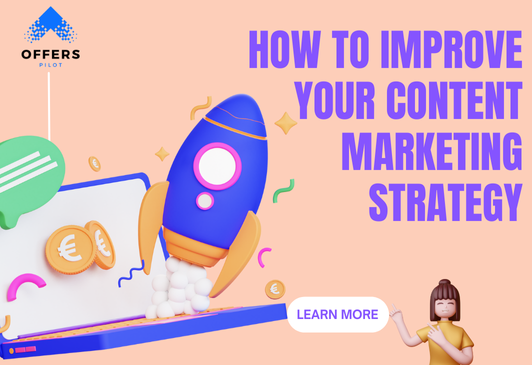How to Improve Your Content Marketing Strategy
Content marketing isn’t just throwing blog posts at your audience and hoping something sticks. Nope. It’s a deliberate, ever-evolving dance between your brand and your audience—like dating, but with less ghosting and more analytics.
In this guide, we’re going to break down how to seriously upgrade your content marketing game. Whether you’re just starting out or trying to fix a flatlining strategy, this article has you covered.

Understanding Content Marketing
What is Content Marketing?
At its core, content marketing is creating and sharing valuable, relevant content to attract and engage a clearly defined audience—with the end goal of driving profitable customer action. Think blogs, videos, emails, podcasts, ebooks—basically, helpful stuff that isn’t just a sales pitch.
Why Content Marketing Still Reigns Supreme
Because people are tired of being sold to. They want help. They want answers. They want to feel like your brand gets them. Great content builds trust. And trust? That’s the secret sauce that converts strangers into loyal customers.
Evaluating Your Current Strategy
Before you start tossing in shiny new tactics, you’ve gotta know what’s working—and what’s falling flat.
Analyzing Existing Content
Take a hard look at your current content. What’s getting traffic? What’s converting? What’s collecting digital cobwebs? Tools like Google Analytics and SEMrush are your besties here.
Reviewing Audience Engagement Metrics
Clicks are cool, but what about time on page? Comments? Shares? Conversion rates? If your content is getting seen but not acted on, something’s off.
Identifying Gaps and Missed Opportunities
Are there questions your audience is asking that you haven’t answered yet? Are competitors ranking for terms you’ve never even touched? That’s gold waiting to be mined.
Setting Clear and Measurable Goals
You can’t improve what you don’t measure.
Define SMART Goals
Make your goals Specific, Measurable, Achievable, Relevant, and Time-bound. “Increase blog traffic by 30% in 90 days” beats “get more readers” any day.
Align Goals with Business Objectives
If your goal is to sell software, your content should help users solve problems your software solves. Otherwise, it’s just noise.
Knowing Your Audience Inside and Out
If you’re not creating content for someone specific, you’re creating content for no one.
Building Buyer Personas
Personas help you visualize your ideal customer. What keeps them up at night? What motivates them? What language do they use? Knowing this lets you craft content that feels tailor-made.
Conducting Audience Research
Use surveys, social listening, and direct conversations to understand your audience’s pain points and preferences.
Tools to Help You Understand Your Audience
-
Google Analytics – for demographic and behavior data
-
Hotjar – to see how users interact with your site
-
Answer the Public – to find common questions in your niche
Creating Killer Content That Converts
Let’s talk about crafting content that not only grabs attention but holds it.
Focus on Value Over Volume
Posting every day means nothing if your content is bland. Instead, post when you have something valuable to say.
Use Storytelling to Connect Emotionally
Humans love stories. Wrap your message in a relatable narrative, and you’ll stick in your reader’s mind like a favorite movie quote.
Mix Up Your Content Formats
Not everyone loves reading. Some want videos. Others love podcasts. Mix it up: infographics, tutorials, webinars, case studies—the more variety, the better.
Optimizing for SEO Without Sounding Like a Robot
Yes, SEO matters. But your reader should never feel the SEO.
Keyword Research: The Right Way
Don’t chase high-volume terms just because they’re shiny. Find keywords your audience is actually searching for—and that you can realistically rank for.
On-Page SEO Best Practices
Make sure your content includes:
-
Clear H1 and H2 tags
-
Internal and external links
-
Meta descriptions
-
Alt text for images
-
A mobile-friendly layout
Writing for Humans, Optimizing for Search
Use keywords naturally. Write like you’re talking to a friend. Google’s smarter than ever—it knows when you’re trying too hard.
Leveraging Content Distribution Channels
Even the best content needs a push to get seen.
Social Media
Each platform needs a tailored approach. Instagram loves visuals. Twitter loves bite-sized takes. LinkedIn? Bring the expertise. Don’t copy-paste—adapt.
Email Marketing
Still one of the highest ROI channels. Send out newsletters, content roundups, and exclusive guides to your list. Always be nurturing.
Collaborations and Guest Posts
Partner with influencers or other brands in your niche. Guest post on industry blogs. This builds backlinks, authority, and reach.
Updating and Repurposing Old Content
Why reinvent the wheel when you’ve got great stuff already?
Identify Evergreen Content
Find old posts that are still relevant. These are prime candidates for an update.
Refresh and Expand Existing Articles
Add updated stats, new examples, better visuals, and improved SEO structure. Re-promote as “updated for [year].”
Repurpose Into New Formats
Turn blog posts into YouTube videos. Break long guides into social media carousels. Transform webinars into ebooks. One idea = many formats.
Measuring Success and Adjusting Accordingly
You need to know what’s working so you can double down—and what’s not so you can pivot.
Key Metrics to Track
-
Traffic
-
Time on page
-
Bounce rate
-
Conversion rate
-
Backlinks
-
Engagement (likes, shares, comments)
Using Analytics Tools Effectively
Google Analytics, HubSpot, Ahrefs, and even social media insights all give you the numbers. But insights are where the magic happens. Don’t just track—analyze.
Final Thoughts on Leveling Up Your Content Strategy
Content marketing isn’t a one-and-done task. It’s a long game. But with the right strategy—built on understanding your audience, setting goals, creating quality content, and constantly improving—you’ll start seeing results that go beyond just traffic.
Remember: Content isn’t king. Useful content is. Make it helpful. Make it human. And the rest will follow.
FAQs
1. How often should I publish content?
Quality beats quantity. Aim for consistency—once a week or biweekly—but make sure each piece offers real value.
2. What tools can I use to improve my content marketing?
Try tools like SEMrush for SEO, Grammarly for editing, Canva for visuals, and Google Analytics for tracking performance.
3. Should I focus on blogs or video content?
It depends on your audience. Test both! If your audience engages more with video, lean into that. Otherwise, written content might be your sweet spot.
4. How long does it take to see results from content marketing?
Usually 3–6 months, but it can vary. The key is consistency, analysis, and iteration.
5. What’s the biggest mistake people make in content marketing?
Creating content for themself instead of for their audience. Always lead with value—what’s in it for the reader?
